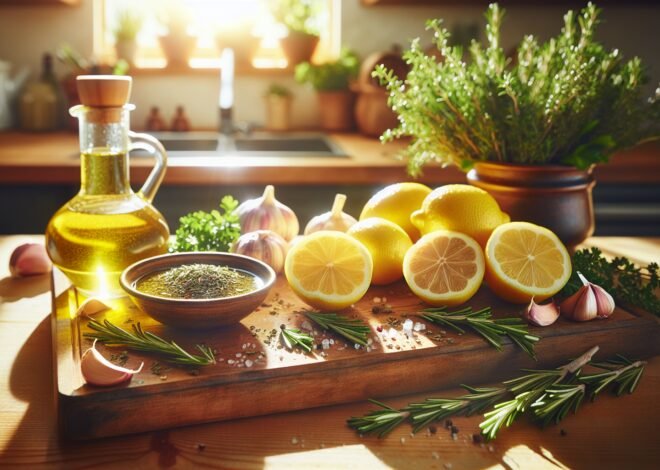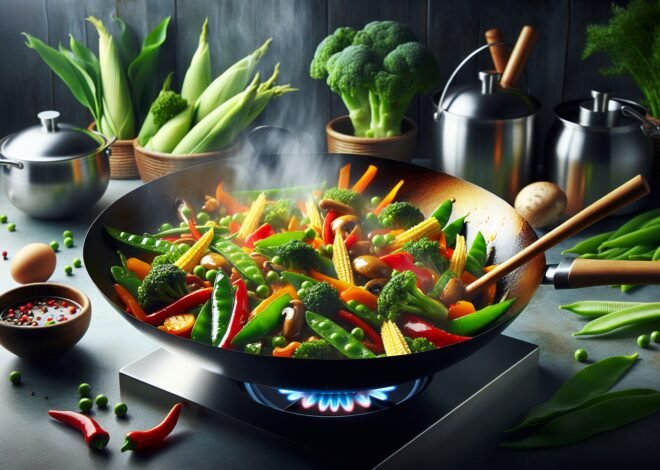
Top 20 Tips for Using Fresh Herbs in Cooking
Tips for using fresh herbs can elevate your cooking from ordinary to extraordinary by enhancing flavors and adding vibrant colors. Fresh herbs like basil, cilantro, and rosemary not only enrich the taste but also offer numerous health benefits, reducing the need for additional salt or fats in dishes. In this post, explore the top 20 tips for maximizing the flavor, storage, and versatility of fresh herbs in your kitchen. You’ll discover how to properly chop herbs, the best time to add them during cooking, and clever ways to store them for prolonged freshness. Dive into how these simple yet powerful ingredients can transform your culinary creations.
Benefits of Using Fresh Herbs in Your Cooking
Fresh herbs have the power to transform your dishes with vibrant flavors and aromas. Incorporating them into your cooking can elevate not only the taste but also the nutritional value of your meals. Additionally, choosing fresh herbs over dried ones supports sustainable practices. Let’s explore how fresh herbs can enhance your culinary experience.
Enhancing Flavor with Fresh Herbs
Fresh herbs can make a significant difference in the flavor profile of your dishes. Their aromatic oils and bright flavors bring depth and complexity to any meal. Unlike dried herbs, fresh varieties offer a more intense and lively taste, making them a favorite among chefs and home cooks alike.
When using herbs like basil, cilantro, or parsley, you’ll notice how they can brighten up a simple salad or soup. The freshness of these herbs releases a burst of natural flavor, which can complement or even elevate the main ingredients. Consider adding fresh herbs towards the end of cooking to preserve their vibrant taste and aroma.
For dishes that require simmering, like stews or sauces, fresh herbs can infuse the entire dish with their essence. Bay leaves, thyme, and rosemary are perfect for this technique, as their flavors intensify when cooked slowly over time. Using fresh herbs in this way ensures that every bite is rich and flavorful.
Health Benefits of Incorporating Fresh Herbs
Incorporating fresh herbs into your diet goes beyond taste; it also offers numerous health benefits. These greens are packed with essential vitamins, minerals, and antioxidants that contribute to overall well-being. For instance, fresh parsley is rich in vitamin C and K, promoting healthy bones and a robust immune system.
Similarly, basil and oregano contain potent antioxidants that help fight inflammation and protect against chronic diseases. The natural compounds found in these herbs can support heart health, improve digestion, and even reduce the risk of certain cancers. Adding a handful of fresh herbs to your meals is a simple and delicious way to boost your nutrient intake.
Herbal remedies have been used for centuries, and science continues to validate their benefits. Fresh herbs like mint can aid in digestion, while cilantro is known for its detoxifying properties. By using fresh herbs, you’re not only enhancing flavor but also harnessing their medicinal potential.
Environmental Impact of Choosing Fresh Herbs Over Dried
Choosing fresh herbs over dried ones can have a positive impact on the environment. Fresh herbs often require less processing and packaging, leading to a reduced carbon footprint. When you opt for locally-sourced fresh herbs, you’re supporting sustainable farming practices and reducing transportation emissions.
Growing your own fresh herbs is another eco-friendly option. A small herb garden can provide a continuous supply of fresh ingredients while promoting biodiversity. Herb gardens attract beneficial insects and contribute to a balanced ecosystem. By cultivating your own herbs, you’re making a small yet meaningful contribution to environmental conservation.
Furthermore, fresh herbs can help reduce food waste. Since they are typically used in smaller quantities than dried herbs, there’s less chance of them going unused. Their vibrant flavors can replace other ingredients, cutting down on waste and promoting more sustainable cooking practices.
How to Properly Store Fresh Herbs for Longevity
Storing fresh herbs correctly ensures you can enjoy their vibrant flavors for as long as possible. Proper storage techniques help maintain their freshness, flavor, and nutritional value. Whether you’re refrigerating, freezing, or storing herbs in water, there are specific methods to keep them at their best.
Best Methods for Storing Fresh Herbs in the Refrigerator
Refrigeration is one of the most effective ways to keep fresh herbs vibrant and flavorful. Different herbs require different storage methods to maximize their shelf life. For soft herbs like basil and cilantro, trimming the stems and placing them in a jar with water, loosely covered with a plastic bag, is a great method.
Hardier herbs like rosemary and thyme benefit from a slightly different approach. Wrap these herbs in a damp paper towel and store them in an airtight container or a resealable plastic bag. This method helps retain moisture, preventing the herbs from drying out too quickly.
It’s essential to store fresh herbs in the coldest part of the refrigerator without letting them touch the back wall to prevent freezing. By following these storage techniques, your herbs remain fresh and flavorful, ready to enhance any dish.
Freezing Fresh Herbs Without Losing Flavor
Freezing is an excellent option for preserving fresh herbs without sacrificing their flavor. While some herbs lose their texture when frozen, their essential oils and taste remain intact. Start by washing and drying the herbs thoroughly to remove any dirt or debris.
One effective way to freeze herbs is by using an ice cube tray. Chop the herbs and fill each compartment with them, then top off with water or olive oil. Once frozen, transfer the herb cubes to a resealable bag and use them as needed. This method is perfect for herbs like parsley, chives, and dill.
Another approach is to freeze whole sprigs on a baking sheet. Once frozen, store them in a freezer-safe container. This technique works well for sturdier herbs like rosemary and sage. Freezing your herbs allows you to enjoy their fresh flavor throughout the year.
Tips for Storing Fresh Herbs in Water
Storing herbs in water is a simple yet effective method to keep them fresh. This technique is particularly useful for soft-stemmed herbs like mint, cilantro, and basil. Start by trimming the ends of the herb stems and placing them in a jar with about an inch of water.
Cover the herbs loosely with a plastic bag and store them in the refrigerator. Change the water every few days to maintain freshness. This method allows the herbs to continue absorbing moisture, keeping them vibrant and ready for your next culinary creation.
For basil, consider storing it at room temperature instead. This herb is sensitive to cold and can turn black if refrigerated. By following these simple steps, you can enjoy the delightful flavors of fresh herbs whenever you need them.
Cooking Techniques to Maximize Herb Flavor
Unlocking the full potential of fresh herbs in your cooking requires the right techniques. Knowing when to add them, how to pair them with different cuisines, and ways to preserve their flavor will enhance your culinary creations. Let’s delve into methods that maximize the impact of fresh herbs in your dishes.
When to Add Fresh Herbs for Optimal Taste
Timing is crucial when it comes to adding fresh herbs to your dishes. Soft herbs like parsley, basil, and cilantro are best added at the end of cooking. This preserves their bright flavors and vibrant green color. Adding them too early can result in flavor loss and discoloration.
For dishes that require longer cooking times, such as stews and braises, robust herbs like rosemary, thyme, and bay leaves can be added at the start. Their flavors develop beautifully over time and infuse the dish with a rich, aromatic essence.
Experiment with different timing to discover how herbs can transform your meals. A sprinkle of fresh herbs just before serving can make all the difference, adding a final burst of flavor and visual appeal.
Pairing Fresh Herbs with Different Cuisines
Understanding how to pair herbs with various cuisines can elevate your dishes to new heights. Italian cuisine often features basil, oregano, and parsley, adding a distinctive Mediterranean flair. These herbs complement tomatoes, cheeses, and olive oil beautifully.
In Asian cooking, herbs like cilantro, Thai basil, and mint are staples. They provide a fresh counterbalance to spicy and savory flavors in dishes like curries and stir-fries. Middle Eastern cuisine makes use of mint, parsley, and dill, enhancing the flavors of lamb, yogurt, and grains.
Experimenting with different herb combinations allows you to explore global flavors right in your kitchen. By understanding these pairings, you can create authentic and delicious dishes that delight the senses.
Preserving Herb Flavor in Cooked Dishes
Preserving the flavor of fresh herbs in cooked dishes requires thoughtful techniques. One method is to infuse oils or butters with herbs before cooking. This allows the herb essence to permeate the dish without overpowering delicate flavors.
Another approach is to create herb pastes or pestos. These concentrated mixtures can be stirred in just before serving, ensuring the herbs’ vibrant taste shines through. Consider making a batch of basil pesto or chimichurri for convenient flavor boosts.
Using fresh herbs as a garnish is also an effective way to maintain their flavor. A sprinkle of chopped chives or a few basil leaves can enhance the aroma and taste of a dish. These techniques ensure that fresh herbs remain a star component in your culinary creations.
Conclusion
Fresh herbs should be added towards the end of cooking to preserve their flavor and aroma. Pairing herbs with complementary ingredients enhances the overall taste of a dish. Storing fresh herbs properly in the refrigerator can extend their shelf life. Washing herbs gently under cold water and drying them thoroughly helps maintain their freshness. Experimenting with different herb combinations can elevate simple meals into flavorful dishes.
FAQ
How do you properly store fresh herbs to maintain their flavor?
To keep herbs fresh and flavorful, wrap them in a damp paper towel and store them in a resealable plastic bag in the refrigerator. For herbs like basil, keep them in a glass of water at room temperature, similar to a bouquet of flowers.
What are the best methods for chopping fresh herbs without losing their aroma?
For the best results, use a sharp knife or herb scissors to chop herbs. A rocking motion helps preserve their oils and aroma. Avoid using a dull knife, as it can bruise the herbs and diminish their flavor.
Which fresh herbs pair well with specific types of dishes?
Basil complements Italian dishes and tomato-based sauces, while rosemary is perfect for roasted meats. Cilantro is excellent for Mexican and Asian cuisines, and dill enhances seafood and yogurt-based sauces. Experiment with different pairings to find your preferred combinations.
How can you substitute dried herbs for fresh herbs in recipes effectively?
When substituting dried herbs for fresh, use one-third of the amount called for in the recipe. Dried herbs have a more concentrated flavor. Add them earlier in the cooking process to allow their flavors to develop.
What are the health benefits of incorporating fresh herbs into meals?
Fresh herbs are rich in antioxidants, vitamins, and minerals. They can enhance digestion, reduce inflammation, and provide essential nutrients. Including a variety of herbs in your diet can support overall health and wellness.
How do you prepare and clean fresh herbs for cooking or garnishing?
Rinse herbs under cold running water to remove dirt and debris. Use a salad spinner or gently pat them dry with a clean towel. Trim the stems if necessary, and chop or tear the leaves according to your recipe’s requirements.











